
Nov 13th 2023 – You can find my full in-depth review of the Polar Vantage V3 posted now! This includes tons of accuracy testing, reliability testing, 12-hour treks, and more. Dive in!
Polar has just announced their newest watch – the Polar Vantage V3. With this 3rd generation watch, Polar is focusing heavily on the hardware – swapping out the MIP-based display for a new AMOLED display, while concurrently upgrading the GPS/GNSS chipset to multiband/dual-frequency. However, the biggest ticket item on the docket is going to be the addition of offline maps, allowing you to see not just the rivers, towns, and streams around you – but also topographic contour lines. Oh, and then there’s the new optical heart rate sensor, skin temperature sensor, SpO2 sensor, ECG, and more.
In this post I’m going to dive into all the new features with a look at how they actually work in real life. Note that this isn’t a full review – that’ll come later, once the unit has final firmware and starts shipping later this month. However, this device is a final production device from a hardware standpoint.
With that – let’s dive into it!
What’s New:
This is unquestionably the biggest leap in a watch Polar has made in years – arguably, the biggest technological leap they’ve ever made since the addition of GPS. While many of these features are found on competitor watches, for Polar, this type of jump is a big deal. And, for the larger endurance sports market and consumers alike, it’s important to see Polar coming back with viable options.
Here’s all the big-ticket items that are new on the Polar Vantage V3. Or at least, everything I’ve found thus far. Undoubtedly there are plenty of even smaller tweaks along the way I haven’t found yet.
– Added offline mapping, with free global maps at high detail levels
– Added/switched to 1.39” AMOLED display
– Added dual-frequency/multiband GNSS (GPS) chipset
– New optical heart rate sensor version (Gen4)
– Added new ‘Elixir biosensing’ technology, which is their new algorithm fusion thingy
– Added SpO2 sensor (blood oxygen levels)
– Added ECG capabilities (note: not certified as a medical device, however)
– Added skin temperature sensor
– Added skin temperature tracking feature and baselining/guidance
– Added virtual flashlight (display-based)
– Increased GPS battery time to 43 hours (full fidelity tracking), and 140 hours (reduced tracking rates)
– Increased CPU speed by 129% for faster user interface usage
– Increased internal storage to 32GB for saving multiple map regions/continents
– Smartwatch regular usage battery life is 8 days, or ~5 days with always-on display enabled
– Switched to standard 22mm straps (without adapter required)
– Switched charging cable to USB-C (watch-side connector is still propriety)
– Watch is water-resistant to 50m, and has Gorilla Glass 3 (curved)
– Pricing is $599USD, shipping October 25th, 2023
In the rest of this first-look style post, I’ll give an explainer of these features. Keep in mind that again, this isn’t a review. The firmware isn’t final, and thus, I’ll reserve final judgment of how well things work, once it is. Of course, in this post I’ll also cover the features, and where they stand in relation to the norm of other devices.
With that – let’s dive into it!
AMOLED Display & Dual-Frequency GPS:
First up is the new 1.39″ AMOLED touchscreen display (462ppi), which has a peak brightness level of 1,050 nits, or essentially the same as most of the other AMOLED displays out there, save the new Apple Watch Series 9 & Apple Watch Ultra editions (2,000/3,000 nits respectively). Still, as I’ve said on several reviews lately, ~1,000 nits for AMOLED displays is plenty bright to see in direct sunlight. It has been for a few years. These aren’t the AMOLED displays of yesteryear.
As a very simplistic demonstration of that – here’s the Polar Vantage V3 display at noon in full sun brightness in Hawaii, taken today. I’ve had no issues seeing it in either dreary overcast days in the Netherlands, nor on nice sunny days on a tropical island.
In fact, it’s those typical Dutch dark days that AMOLED displays are better than MIP-based displays (which is what the Polar Vantage V2 and prior had). As I’d complained in multiple reviews lately, Polar’s MIP-based displays weren’t great from a visibility standpoint – and desperately needed an update. This delivers that update.
Even in the shade, or at night, it’s super bright:
And, with that, Polar added a new flashlight mode. This uses the display as a flashlight:
Next, is the new multi-band GNSS chipset. Multi-band, or dual-frequency GPS, is effectively the ‘holy grail’ of GPS technology. It uses two different frequencies, which can help to deal with obstructions or interference better, as it has access to more satellites as well. In the case of the Polar Vantage V3, you’ve effectively got two core options when it comes to GPS settings. You can use full multi-band/dual-frequency, or single-frequency.
Now, what’s more notable here is Polar’s changing of their antenna design. Most of these companies are actually using the same GPS chipset in their watches, yet their performance is significantly different. Take Garmin vs COROS for example. Both have used the exact same chipset in their multi-band watches, yet Garmin’s GPS performance in those dual-frequency watches is universally agreed upon by reviewers as superior. Similarly, when Polar launched their Ignite 3 a year ago with multi-band/dual-frequency), it didn’t do well at all GPS-wise.
Why? Antenna design.
It’s incredibly critical to good GPS reception, particularly in challenging environments. In a recent conversation with another watchmaker, Suunto, they talked about how fractions of a millimeter made the difference between incredible performance and unacceptable performance. Of course, companies can’t just copy/paste this from Garmin (and even Garmin can’t copy/paste to themselves), because each watch case/bezel/materials design is different – and all of that impacts accuracy.
All of which is a long-winded way of noting that Polar explicitly noted their antenna design has changed here with the Polar Vantage V3, in an effort to ensure they had better GNSS/GPS tracks for this higher-end watch.
Of course, I’ll save the full GPS accuracy testing for my in-depth review on the final firmware. That’ll include everything from challenging skyscraper style building tests, to mountains and jungles, and just regular activities on easier terrain. Polar explicitly noted that the firmware related to the GPS tracking portions isn’t final yet on the unit I have. Thus, be wary of anything else out there titled a review until the October 25th timeframe.
Topographic Mapping:
Arguably the biggest feature on the Polar Vantage V3 is the new mapping capabilities. This is the first time we’ve seen offline maps on a Polar watch, and follows just months after we saw Suunto add it in their new Suunto Vertical (and to a sorta-extent, Apple on the Apple Watch in WatchOS 10). This appears to be the year of the offline map, finally.
In Polar’s case, they’ve added 32GB of storage inside the Vantage V3 – dedicated virtually exclusively to maps. I say exclusively, because there’s no onboard music capabilities – so about the only thing you’re gonna use that space for is maps (workout/activity files are trivially small, usually measured in the 30-100KB range per hour).
The first step is getting the maps you want on the watch. By default the Vantage V3 will come with the European and North American maps pre-loaded in a ‘Basic’ configuration. However, you can easily download other regions, and the more detailed maps, for free, via Polar Flow. To do so, you’ll go to flow.polar.com/maps to get started (that site only works if you have a Polar Vantage V3 registered on your account). Which brings you here:
You’ll see you’ve got two options to begin with: Basic or Detailed.
Basic maps show the general gist of things, including main roads and town names. Whereas ‘Detailed’ maps show down to the names of rivers/streams, as well as small trails. Additionally, detailed maps include topographic contour lines.
From a basemap standpoint, Polar loads both the North American and European ‘Basic’ maps by default, which in total take up about 15.3GB of storage (8.4GB for Europe, 6.8GB for North America). From there, you’d likely want to add detailed maps for the country or region that you want more detail on. You can see how this is divided up in various spots:
For context, here’s some random map sizes for the ‘Detailed’ maps:
– USA West: 4.9GB
– USA Midwest: 2.3GB
– USA Northeast: 1.1GB
– USA South: 3.4GB
– Canada West: 4.1GB
– Canada East: 3.8GB
– Canada North: 6.1GB
– France 2.7GB
– Spain and Andorra: 1.3GB
– Germany: 2.4GB
– Australia and Oceania: 5.2GB
– Brazil: 6.0GB
– South-east Asia: 7.0GB
Generally speaking, from the above quick-hit list, you can probably figure out a ballpark for your specific region. Interestingly, there’s only ‘Basic’ maps offered for North America & Europe. You can’t get a ‘Basic’ map for anywhere else, only detailed.
Now, once you select the region you want, you’ll choose to download the file, which is simply a single file.
In case it isn’t clear at this point, downloading maps requires a computer of some sort. You’ll need your Polar Vantage V3 connected via the included USB-C cable, which then makes the watch appear as a standard USB mass storage device (like a thumb drive). You’ll take said map file, and simply drag it onto the watch. Done, it’s as simple as that.
Now, over on the watch, you’ll see your maps as part of a map page:
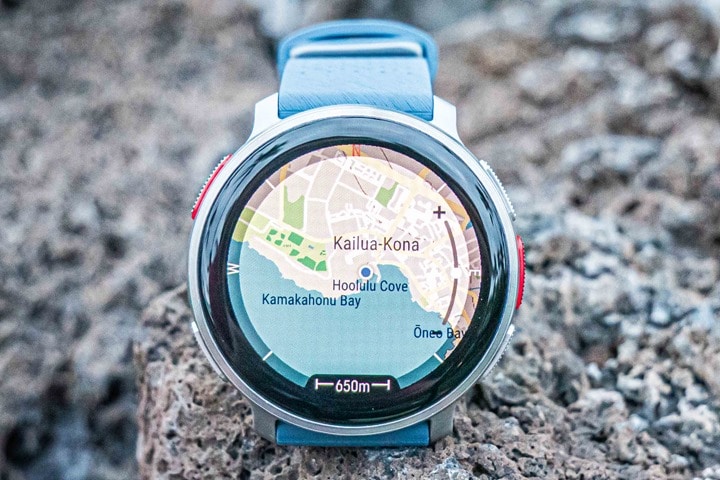
You can zoom/pan/etc on the map using the touchscreen, and the responsiveness is reasonably good.
From a routing standpoint, the Polar Vantage V3 has turn-by-turn routes when paired with Komoot routes. This means it’ll give you upcoming turns, which are overlaid atop the maps. Note that the Vantage V3 cannot re-route on the fly, nor can it do routing without a pre-planned route. The exception for that is routing back to the start, in which case it’s either doing a route as the crow flies, or following the exact path you took to get there. I point that out, because the level of routing that Polar has is equal to Suunto and COROS, but falls short of Garmin’s ability to dynamically re-route you, or create routes between points on the fly. These are effectively different tiers of the mapping capabilities. Likewise, waypoints are not supported at this time.
If you go off-course on the Vantage V3, it’ll simply tell you how far off-course, but won’t dynamically re-route you back to your planned route on alternate trails. You will however see those trails on the map (unless you’re out in a field, or in the ocean, in which case…umm…good luck).
Polar says that this is their starting point for going deeper in the mapping realm, both with respect to connected providers (e.g., Komoot), as well as the features/functionality around maps/routing on the watch itself.
New ECG-Capable Heart Rate Sensor:
Next, Polar has added a new optical sensor to the Vantage V3, which they’re officially titling as “Gen 4”. This new optical HR sensor is paired with a new skin temperature sensor, as well as a new blood oxygen sensor. This is the first time we’ve seen Polar have either of those features. They’ve previously had neither in their watches.
Additionally, and most notably, this is the first time ECG (electrocardiogram) has been included in a Polar wearable product. Starting with that, to take an ECG, you’ll tap down to the ‘Tests’ section, and then ECG’.
It’s here you’ll see the new ECG screen, which requires you to place your other hand on the upper left button. That completes the ‘circuit’, allowing proper measurement. Once you’ve done that, you’ll start to see the ECG trace:
After 30 seconds of showing you the trace/signal, the ECG will be complete. On the watch you’ll see average HR, HRV, and beat-to-beat interval.
At that point it’ll save the results to Polar Flow, where you can view the results and export out a PDF to take to your doctor.
Now, it’s really important to note this is substantially different than what Apple, Garmin, Google/Fitbit, Samsung, and others are providing. Very very different. To begin, Polar is not claiming to be a medical device (certified or otherwise). Instead, they are saying they are merely providing a trace that you can talk with your doctor about. While the company says they are interested in the medical realm, and have history there, at present, the Polar Vantage V3 is not a medical device from an ECG standpoint.
Feature-wise, the differences are arguably even more important in this context. All the others (Apple/Garmin/Fitbit/etc) are doing what’s called ‘Afib detection’, meaning, they’re looking for signs of an abnormal rhythm – either manually (when doing an ECG), or as a background process 24×7. Polar is doing neither. Thus, while you can take and record an ECG anytime you’d like on the Vantage V3, Polar is not going to tell you if it found an abnormal result (whereas the others are).
Now, while I appreciate what Polar is doing here – I think in this context, given the existing landscape of the wearables world and certified ECG devices, that Polar’s marketing/implementation is probably misleading. While I agree it’s technically correct, the average consumer will see what they are doing, and assume the ECG will provide feedback as seen in countless “this saved my life” news stories over the past few years. The Vantage V3 won’t do that. It’s merely going to take a trace that you can send to your doctor. That trace could indeed show signs of something concerning, but it’s not going to give you instant feedback.
Hopefully though, as Polar says, with their interest in the medical realm, we’ll see them make that leap towards a proper FDA or EU/CE certified medical device. But that process is typically at least a year, if not often much longer.
Initial Thoughts:
Now, like always, I’ve got my full in-depth review coming. That’ll be timed to when the unit actually starts shipping later in October. I generally prefer to align my reviews with the final firmware – to ensure there isn’t a case where the end-state firmware doesn’t match earlier firmware. While the unit I’m testing is final hardware, there are a few bits not yet finalized on the firmware side – hence, the date gap.
The key thing I’m really digging into on the GPS side is ensuring that Polar’s new multi-band GPS chipset is acting like a proper high-end multi-band chipset. Meaning, on the Polar Ignite 3 last year, Polar’s multi-band implementation simply wasn’t good, easily beaten by lesser watches without multi-band GNSS. To rectify that on the Polar Vantage V3, Polar says they’ve re-architected the antenna design. While people often focus on GPS chipsets, the cold-hard truth is it’s antenna design these days that separates incredible, from good. Literally fractions of a millimeter one way or another in the antenna design is the difference between those two.
In any event, from an overall product standpoint, I think Polar is on the right track here. They’ve checked off key boxes they needed to check off badly, most notably maps and an AMOLED display, but also a theoretically more accurate GNSS solution. Likewise, I’ll also be looking to see if the new optical HR sensor can improve upon some of the minor blips that the previous Vantage series was known for.
I like the starting point for the maps that Polar has here. The maps look great, and are responsive. And downloading them is easy enough. As noted earlier, while the Polar Vantage V3 lacks WiFi entirely, from a map-downloading standpoint while traveling, it’s actually not a bad thing to allow USB downloads of maps. Watches don’t tend to work with most hotel WiFi networks, so having the option to simply download a big file and transfer via USB is most functional for last-minute additions.
In my full review, I’ll dive into some of the gaps that I see here, such as the lack of routing providers (e.g., Strava Routes) as well as re-routing capabilities. But these can largely be solved via software updates. I wouldn’t expect anything like onboard music support or contactless payments. Polar simply won’t be able to get the business contracts in place at their scale, to make that work (for streaming platforms like Spotify, or payment providers). Instead, like Suunto, they’ll need to make up for those gaps in other sport/fitness-focused areas.
In any event, stay tuned for the full in-depth review, later this month.
With that – thanks for reading!
Found This Post Useful? Support The Site!
Hopefully you found this review/post useful. At the end of the day, I’m an athlete just like you looking for the most detail possible on a new purchase – so my review is written from the standpoint of how I used the device. The reviews generally take a lot of hours to put together, so it’s a fair bit of work (and labor of love). As you probably noticed by looking below, I also take time to answer all the questions posted in the comments – and there’s quite a bit of detail in there as well.
If you're shopping for the Polar Vantage V3 or any other accessory items, please consider using the affiliate links below! As an Amazon Associate I earn from qualifying purchases. It doesn’t cost you anything extra, but your purchases help support this website a lot.
Here's a few other variants or sibling products that are worth considering:
And finally, here’s a handy list of accessories that work well with this unit (and some that I showed in the review). Given the unit pairs with just about any Bluetooth Smart sport sensors, you can use just about anything though.
And of course – you can always sign-up to be a DCR Supporter! That gets you an ad-free DCR, access to the DCR Quarantine Corner video series packed with behind the scenes tidbits...and it also makes you awesome. And being awesome is what it’s all about!
Thanks for reading! And as always, feel free to post comments or questions in the comments section below, I’ll be happy to try and answer them as quickly as possible. And lastly, if you felt this review was useful – I always appreciate feedback in the comments below. Thanks!



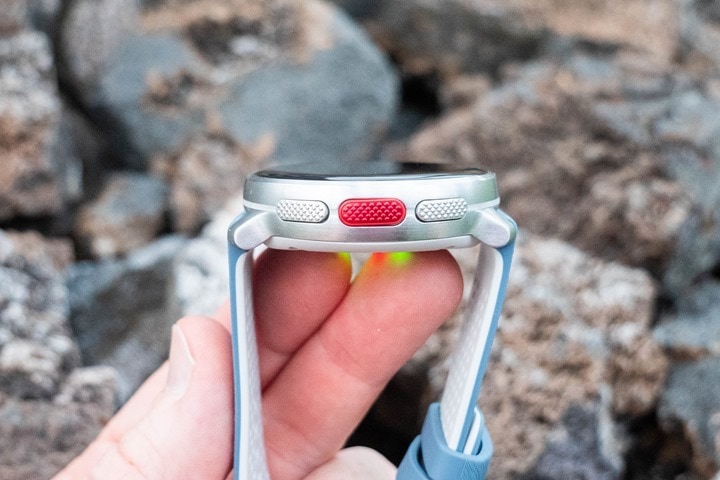

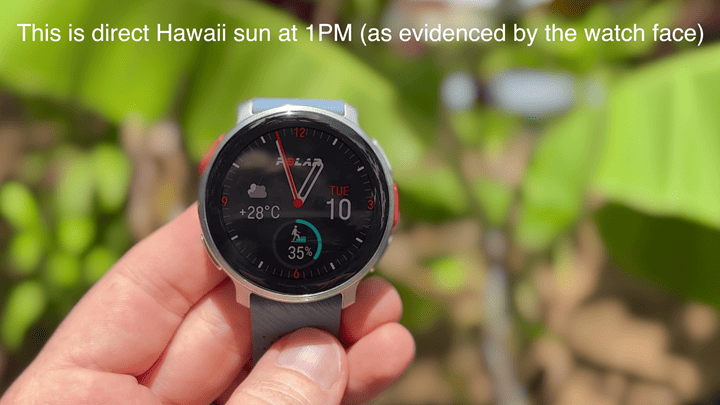
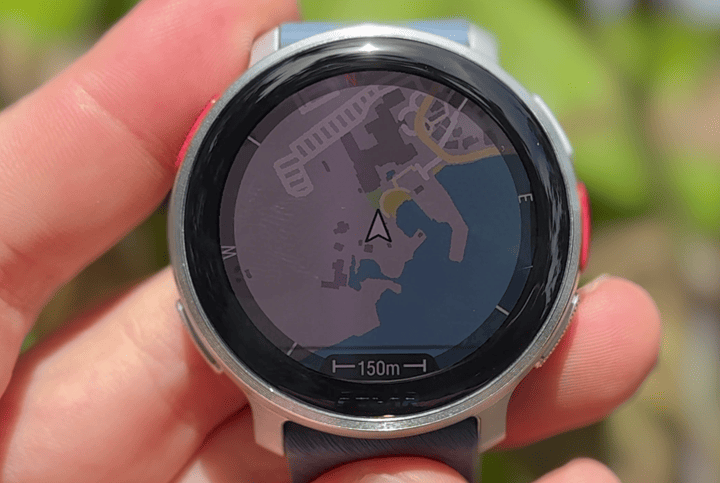
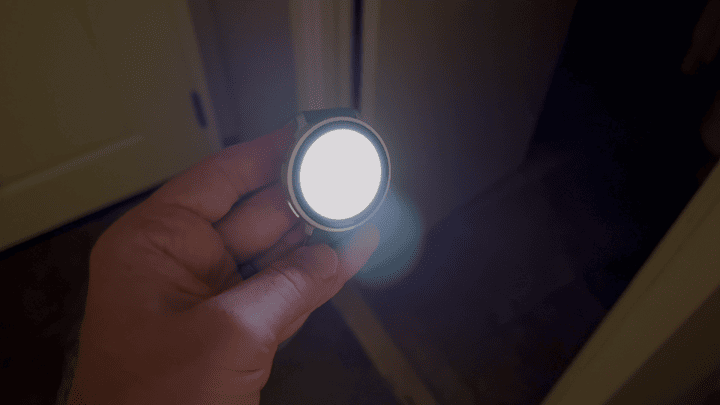
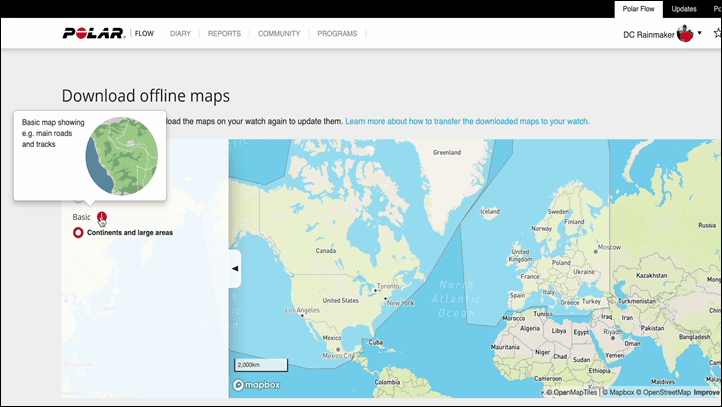
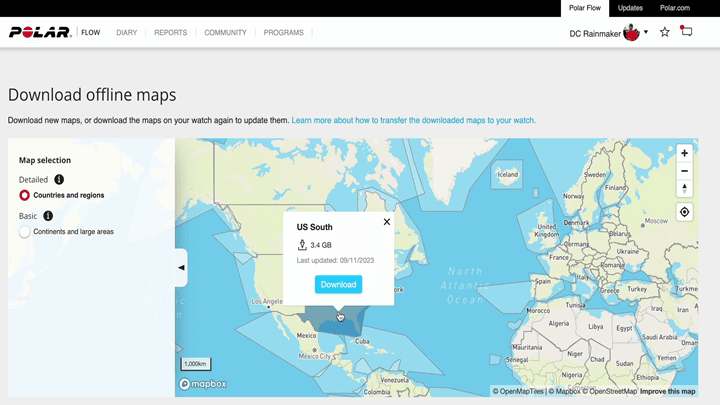
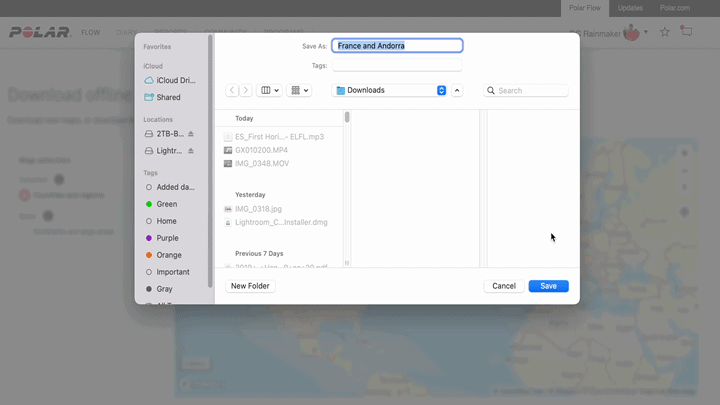
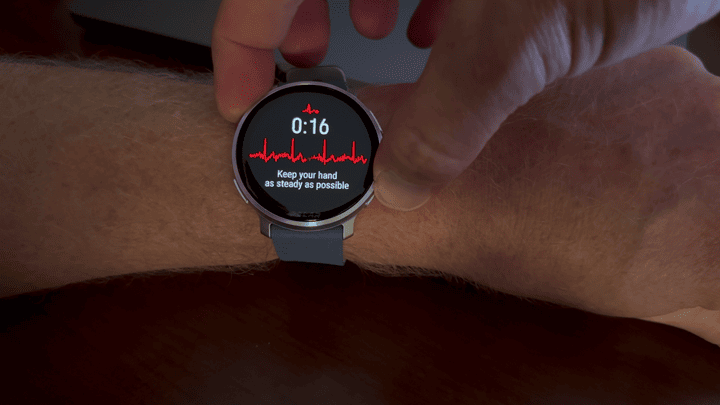
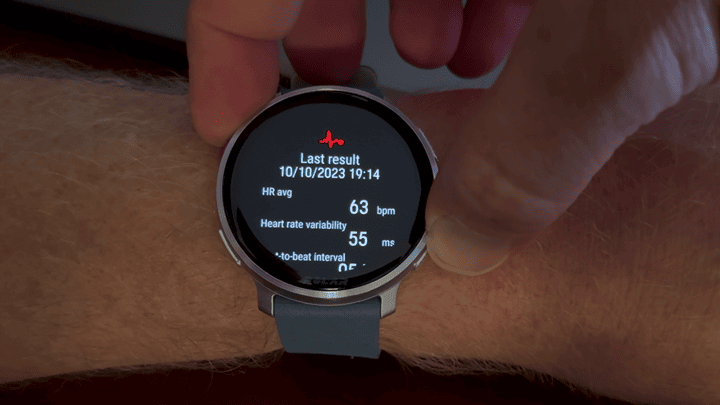
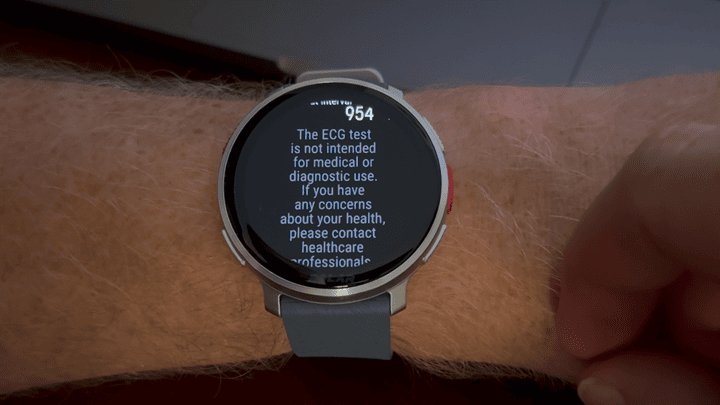
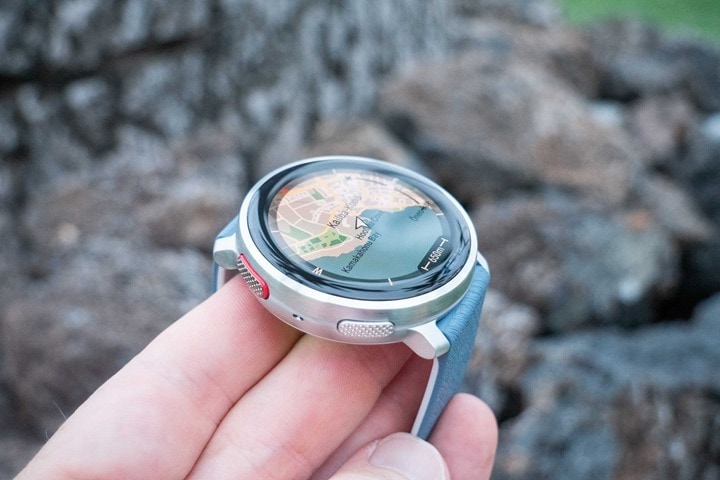
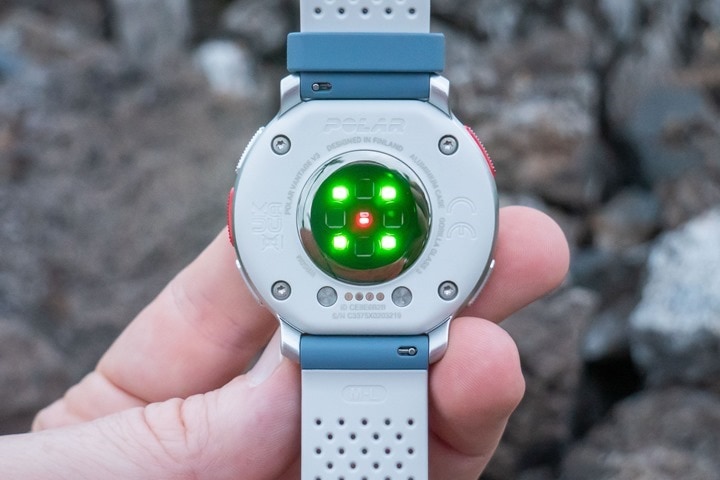

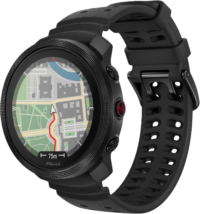
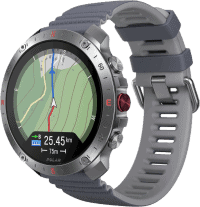
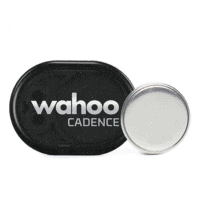
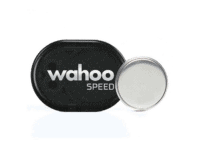

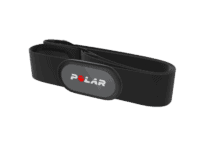
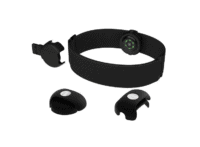

















Seems that there is no navigation to saved POIs in the watch, even without route?
Thanks for coming full review!
-Mark
Correct, no POI’s or waypoints at this juncture.
fyi persistent AMOELD typo ;)
Nice to see they nailed the performance this time!
Would love to see an in depth of the usability of the map + nav features of it!
Thanks!
Looking forward to the review when the watch is released. Because of the release of new watches, action cameras, and drones I am destined to be broke.
In your review could you cover if (or how) its possible to create a route within the Polar app and upload that to the watch to follow?
Cheers!
You can’t. You create the route on Komoot and automatically sync it to watch OR create the route on any other service, them manually upload the route file to Polar Flow and then sync it to watch.
Hello Ray
What’s is the real battery with dual band and screen always on?
Thanks
+1
Curved glass :(
why is that bad?
Ray and hint or word on a Grit X 3? Naturally, the mapping feature would complement that product line nicely. Maybe with a touch better battery life as well. Polar still has some life left!
Would also like to know. I’m upgrading from V2 to 3, husband has the grit x and wants to upgrade as well. He would rather have a grit x3 if its coming fairly soon.
There seem to be a few html elements shown as text on the main page.
It would be good to compare this vs say the Apple ultimate 1 and 2, as well as the equivalent Garmin.
Can you also include whether the time displayed on the usual digital watch interface includes seconds (!), and whether the weather updates correctly with the phone. I find that there are usually delays in syncing with the polar app (I guess because the polar flow app is shut down by the iOS).
As a vantage V owner I’m wondering whether it is worth upgrading. At work I’m considering using timers for meetings much more.
It is sad that the payments platforms are locked down so much. It feels quite sad that there’s a lack of competition here.
Hi, super quick question.
I suppose you can’t mount the watch on the handlebars of your bike: even when it’s always on, the display dims to the point where it’s unreadable in bright sunlight. Or am I wrong? Isn’t this what happens with other companies’ AMOLED displays?
Good question, I would also like to know. In the manual, it says: “With always on chosen, the watch display will be illuminated throughout your training session.” But does that mean the display will not dim either?
I mount my Vantage V2 on my handlebars and don’t use the always on feature and have never had any issues reading the display, even in bright sunlight and wearing sunglasses. Hope that helps
I’ll play around with on-handlebars riding and dimming today.
Other companies are variable. And in fact, even within other companies are variable – for example, I went for a multi-hour ride with the Venu 3, and it never dimmed on my handlebars. Whereas other AMOLED displays from Garmin can/will.
I may have been wrong.
From the V3 manual, here: link to support.polar.com
Always on display, DURING TRAINING
“You can find the Display always on setting from the quick menu in pre-training mode and during a session when paused. With always on chosen the watch display will be illuminated throughout your training session.”
Note also, immediately below, the following caveat:
“Please note that the always on setting will drain your battery much faster than the default setting, and may also impact the lifespan of your display. The default settings are optimized for battery life and display longevity. ”
Ray, do you mind to check, and may be also ask Polar about this longevity part?
Many thanks
It would be nice to test for every AMOLED sporttesters. I will probably replace my old Polar VM with a new VV3 or FR 265/965 and this feature is key for me.
I got this response from polar today:
“Thanks for your
questions! you can attach the watch to your handlebars, and with the always-on mode, the screen does not dim at all, so it is very visible even in bright weather. We do not have any special feature for preventing the screen from burning out during training, but it’s recommended to use a watch view which shows variable metrics such as heart rate data and time. hope this info helps!”
Looking forward to the full review, but also to what else will come from Polar down the line. A cheaper option with MIP and no mapping, but still with the new HR sensor and multi band GPS? Here’s hoping
Not sure, but I think the general shift for most companies is that basically, only the very top-end units with really long battery needs will stay MIP. There just isn’t enough demand in the market anymore for MIP-based displays at the low and medium end.
Sorry need to stop you there. No perceived demand after what is effectively one generation is not enough to decide. I have a Fenix 7 and Epix and rarely use the Epix. I like the screen, but always return to the Fenix for various reasons. Just like with the iPhone mini we shouldn’t use a single generation to decide. Lots of people bought the Epix and I’m sure lots of them will revert next gen if the option is still available. I will certainly stick to MIPS display for lots of reasons, it’s better as a watch, it’s better at night, the battery life is nice. Now and then I’m glad of amoled like in the dark pool at my gym, but not enough to prefer it.
I know you test a lot of watches and read a lot of comments but don’t forget how much power your voice has to kill things that people really want. I will concede defeat of Fenix.next has terrible uptake, but 7pro doesn’t count.
+1 on the iPhone mini comment! ;)
+1 on the iPhone mini comment too
“No perceived demand after what is effectively one generation is not enough to decide.”
But, it’s not just one generation. It’s years of data. It’s nearly half a decade of data on the Venu (AMOLED/LCD) vs Vivoactive line. It’s now almost two years of data with Fenix/Epix. I mean, they know the initial results of that battle within 30-60 days.
For Polar, it’s the same story – they’ve been doing AMOLED/LCD for years now. They know what people want. If the data was showing significant demand for MIP-based displays, as in, massive demand, Polar would invest there. But again, in talking to these companies – the demand is simply not there. This isn’t a made-up thing. Just like Apple, if demand was truly there at the scales Apple needs, they’d sell it.
I think that’s the thing we often forget, the scales that matter here are measured (for Garmin/Apple) in millions of units now.
“I will concede defeat of Fenix.next has terrible uptake, but 7pro doesn’t count.”
Not entirely sure why the Pro doesn’t. It’s the next generation, and arguably, the single best driver of whether people are shifting or not, within the Fenix/Epix lineup.
Thanks for this!
You write: “In my full review, I’ll dive into some of the gaps that I see here, such as the lack of routing providers (e.g. Strava Routes) as well re-routing capabilities.”
In the past one could easily work around this by going to ths strava website, export a saved route and import it on polarflow and then sync with the watch. While this was not easy, but are you saying this will not be possible anymore? (Sorry if I mísunderstood, I am not a native speaker…)
Looking forward to the full review!
I cam to ask the same question!
You can do that still as far as I know, but I’m saying that it’s not native (which is kinda silly, since porting Strava Routes is something countless knock-off/no-name bike computers do today).
Thanks for the clarification! And yes it is silly. But I guess it brings money from Komoot…
A detailed navigation and map comparision between Vantage V3, Suunto Vertical and Coros Vertix 2 would be very interesting to see.
And of course the new Suunto Race…
Is the cpu better? The v1 of Vantage watch was painfully laggy to use.
Yup, it’s a faster CPU. Polar claims it’s 129% faster, which, as shown in the video, definitely seems faster.
Is there now a way to get music onto the device and playback via bluetooth ?
No, not at this point. And given the lack of WiFi, that would hinder connectivity to virtually all music platforms save for dragging/dropping MP3 files, which virtually nobody is doing in 2023. :-/
Drag and dropping MP3 file ;-)
But there is still this problem that when you run, you want to listen to music, but don’t drag the brick heavy device they call cell phone around with you.
Yeah, that’s what I was saying about the lack of WiFi doesn’t stop MP3 drag/drop, but that nobody is really using that – at least on a scale that’s meaningful to justify implementing the feature.
For example, the Suunto Vertical does actually have the hardware components inside to do music playback, if Suunto wanted to invest the developer resources into it. But in talking to them, they came to the same conclusion that what 99% of consumers want is Spotify/Amazon/YouTube Music/Apple Music/etc, and that’s simply not going to happen. That ship has long since sailed.
Thus for them, they’d rather spend their dev resources on various other sports/fitness/etc features. I suspect Polar has come to the same conclusion.
But Huawei gt runner can play music from storage whiteout wifi
Funny thing is, I would love an old fashion, drag and drop for running and biking. When I’m committing are on the plane, I’m happy to use Apple Music Apple podcast as a refreshing streaming service. But I’d really like a replacement for the iPod, nano or iTouch, where I could just build a specific playlist an and updated as I want, use that just for jogging. Phones are so big now no one wants to bring that on a run if they can avoid it.
When I saw ECG capability, I perked up – this would be the all-in-one I was waiting for. But your precision reporting quickly quelled my hopes – and kept me from wasting a few hundred dollars. We’ll just have to keep on waiting.
Wait what, no music and/or podcasts? I always listen to podcasts when running and cycling, is there also no onboard music?
Lack of music and payments is a huge deal for anyone who runs without a phone, and while that may be a minority of runners, I suspect it’s disproportionately the hardcore runners that Polar seems interested in targeting.
It seems to me that the only viable way forward is to have some version of a fully-featured watch firmware as a Wear OS app, though I assume that would be highly demanding from a battery and processor standpoint.
The flipside is that every true smartwatch these days (both Android and Apple) has really impressive hardware and incredibly lackluster fitness software. It seems like these things need to come together.
Let’s see what the Fitbit integration for Pixel 2 does.
But what both Apple and Android watches suck is battery life (outside the activities). So even uploading MP3 (for Ray), or AAC (for the rest of us) to something like a Polar or Suunto might be preferable.
Many may want this (music and payments) and it may end up being a majority, but there is a market for those who don’t need it to. I guess the question is is the market big enough for Polar and Suunto. I fit in the don’t need it category, as I have never run with music and don’t feel the need to (even though I used to always carry a phone that could do it). Sure, it’d be great to have these features but not at other monitoring/tracking feature detriment in investment for me.
I thought I wanted it for my first wearable but went with the Pacer Pro as my focus was on tracking my running and sleep monitoring all of which the Pacer Pro seemed to have good pedigree in. It has been great. The only other features I would have liked (would have paid more) weren’t in any Pacer model, and weren’t the mix (features/size) I was after in the COROS or Garmin offerings. But for me, based on specs, the Vantage V3 is exactly what I was after and would buy it if I was in the market today – but I can’t justify the money until I’ve had the Pacer Pro for some time.
I was really looking forward to this, but I think I will stick with my Apple Watch 8. I don’t see any reason to change with this update.
Looking forward to your in depth review. As a Vantage 2 Owner, I have found the Sleep detection and Sleep related features to be sorely lacking in reliability, precision and accuracy. Often discovering the “Why No Sleep Data” display the in the morning. I would be very interested in your in depth review commenting on any advancements and improvements, if any, to the Sleep detection system in the Vantage 3’s compared to the V3. The only information I have seen thus far on Polar’s site are claimed improved interference reduction and movement detection, however, these assertions were not specific to the Sleep detection system. By comparison, I also wear a Fitbit Luxe consistently on my other wrist. It does a far more accurate and consistent night by night reading of sleep data than my V2. Plus, I have sent the V2 for Polar twice to check and service the unit if necessary to improve the Sleep detection features, without improvement.
I have a V2 as well. Make sure you wear it tightly enough at night. I have found if too loose it will not detect sleep properly.
Thanks for your reply. Been there done that! Have worn it so snugly that it throbs, and have tried doing so on either wrist. Still same irregular results. Pales in comparison to entry level Fitbit Luxe. Polar has already had the unit back in service twice to check it. The entire system needs work to improve the accuracy of the results. Not sure I’ll venture into the V3 from my V2 until things improve. My V2 is doing just fine. Maybe the V4 will be better…. YMMV.
I had several Polar watches, currently I have a Pacer Pro.
But I don’t use it for sleep monitoring. Why?
In the evening, if I put the watch on after showering, it often doesn’t measure anything.
link to support.polar.com
“Try wearing your Polar device well in advance (about an hour and a half) of going to bed.”
My Garmins were similarly dumb. A Huawei Band is light years ahead, it cost me ~40 EUR.
At the right price point this will be great. I really loved my Vantage V1 but at the time it cost the same as a Fenix. That’s just not going to fly now given the chasm of functionality difference.
While I still prefer Polar Flow since it was designed to perform a task I did have to concede that Connect had better functionality when I tested head to head on my old site. Connect is designed to be extensible though, it’s the Sharepoint of fitness, it’s crap for everything but does everything.
If they aren’t crazy money I may buy one just to support Polar since their implementation is always superb, as is Suunto’s.
Long time Polar user. I pre-ordered today – will probably be my 12th Polar device I guess.
The only things that Garmin has that I wish this had is “more detailed Stryd metrics and heat acclimation”.
Sad to see how little interest there is in Polar product these days. Announcement day of their flagship product and only 34 comments about 12 hours later…..
What is the contour interval between the topographic counter lines on Polar’s maps? Maybe it is different between different map regions, but which range are we speaking about? I am curious to know how detailed the (detailed) maps are, especially in terrain/off-trail, and I have no access to the Polar map page linked in this article.
Has Polar added or do you know if they have any plans on adding a “track” mode like Coros, Garmin, Wahoo, etc.? Appreciate it!
I haven’t heard anything like that.
Any changes to Polar Flow ? Allowing imports from Zwift would be nice …
You can use RunGap to post from Zwift to Polar Flow. Although I agree, it would be nice for Polar to allow you to upload from other platforms natively.
No changes to the app.
I respect Polar and their decision to not go the route that other companies have gone with the ECG being certified. At least this means this feature should be available worldwide at release and not geolocation locked and unavailable in numerous countries like the other brands devices. There’s certainly nothing stopping them from certifying an algorithm for dysrhythmia detection at a later date. But that said, and as a medical professional, I’ve seen some terrible ECG interpretations done by these certified watches because the users can’t use them properly to provide a clear trace and the watch tell them they have AF when they don’t. I think taking an ECG tracing when you feel symptoms and discussing this with the doctor is a far better option than a watch playing doctor, at least a well trained human can determine the difference between interference in a poor trace and AF. Nothing deceptive from Polar though, they have included an ECG sensor and called it exactly what it is, these by default don’t have to offer an algorithm to automatically detect dysrhythmias. I look forward to picking one of these watches up in the near future.
What I would like to know is, what is the quality and resolution of the ECG trace in comparison to other brands. That’s what really matters with an ECG device, getting a clear and accurate trace for interpretation by a well trained medical professional.
I think though, the point of the other watches detecting something is that it’s still recording that as a PDF to take to your doctor. The bar for correct identification of traces, at least by the FDA, is reasonably high. Thus the vast majority of issues found are likely to be something that needs further attention from a doctor.
I guess I struggle to see how valuable a trace is without any guidance. To me, that’s only worsening the scenario you outlined – people calling their doctors thinking they have an issue – because there’s zero guidance provided.
Personally, I don’t have a use for a trace. But they seem to use the ecg functionality for the orthostatic test, which no longer depends on the H10. Integration with the training and coaching features seems like a valid use case for a non-medical ecg.
My understanding is the on-watch ECG enables Polar’s Orthostatic test to be performed without a chest strap. Huge if true, for users of that feature.
For people that experience paroxysmal dysrhythmias that can only be captured at the time of it occuring, this includes rhythms other than AF, the user could use the ECG feature of this watch, or any ECG capable watch, to capture the rhythm for proper analysis by a doctor later. ECG interpretation is complex and requires knowledge and experience, which a doctor is better at providing when compared to an algorithm. There is plenty of value in ECG rhythm capture if a person has a concern due to experiencing intermittent symptoms, especially when you consider a halter monitor that would normally be used for this sort of investigation is generally only worn for 24hrs not 24/7. Although there is some possible benefit to the watch interpreting if AF is present or not, it’s not the absolute requirement for ECG acquisition. At least this feature will be available to all worldwide users, which is something many of the other watch makers can’t provide due to certification being different in each country.
Concerning accuracy, Polar has recently published a white paper on their website comparing their wrist ECG unit to a Holter monitor. Bottom line is that it is excellent.
Hi Ray, thanks for the first impressions.
Can you say something about the weight? The V3 seems to be quite thicker than the v2.
DCR: I know your home region is pancake flat, but I hope you will please test elevation accuracy on the V3. Or at least shout out Des or someone who does a good one.
The elevation tracking on the V2 is still horrible, 3 years after release. I find it almost always wrong, incorrect during training, from easy open climbs, to multi-hour bike rides with big elevation gains or weather changes. Bad. It has multiple times, for instance, reported me at -100 ft elevation. Yes negative.
I would be interested to understand the improved capabilities in swimming, the Polar site mensions but does not go into details.
Any insights on what that exactly is?
I have the exact same question.
I found the lap swimming capabilities of previous polar watches (Pacer Pro) a bit underwhelming, or at least not very useful.
I’d like to have an automatic split/sets/rest displayed on the watch as Wahoo or Suunto does. Simple and useful.
I’m circling back again. I was told when I asked explicitly that there was no new sports functionality beyond what I outlined above in relation to other features.
Aside from previous support for Komoot, it does not appear that they have added any new third party integrations for structured workouts.
Seems to be a much better map managing system as Garmin offers. The user is able to download only the countries he wants, correct?
No ant+? That would be bad.
Can you share the HR with a wahoo bolt? Doesn’t work on the V22
+1
Believe it may have been available on more recent Polar models.
Key requirement for me to upgrade from Vantage M1
I just tested your comment about Venu 3 not dimming, and my watch here is set for “extra long” on the timeout setting during activity. My watch here dims after 30 seconds. I see your comment #15 saying it never dims, but I cant replicate it. AFAIK all Amoled screens from Garmin should dim, this is to preserve the screen according to the developers. This is on software 6.22, and this is the latest sw. Could you doublecheck if this holds true with latest software?
Are you talking dimming sitting on a table, or sitting on handlebars? As noted, i was specifically talking on handlebars in workout mode, where I suspect the vibrations are at play in keeping it awake. But then again, that’s the use case people are concerned about (versus a table).
I was indeed testing this on a table, so you might be on to something. I take my comment back :P
Hi,
When you import a route into the Polar Flow web service and sync it to your Polar watch there has been the following issue with Vantage 2. If the route is long, it will be compressed into 500 waypoints when you transfer it to your training device. This has made the route funktion unusable for e.g. 100 mile trail races, because the new route in your watch is typically shorter and includes shortcuts. Do you know if Polar have or will make changes to this?
Thanks!
Do you know what kind of maps they are is setting? Openstreetmap?
Commenting my own comment because I didn’t manage to read correction…🧐
*what kind of maps they are using?
f***🤣
Thanks Ray.
Would you be able to share a screen shot of the detailed may for the UK, so I can compare it to the best UK map (Ordnance Survey). Maybe you can search for Glenridding in Cumbria (Lake District), please? Very keen to see the level of detail, thank you.
I have a Grit X but Flow won’t let me access the maps…
Boooo, AMOLED.
I’m fine with it as an option, but MIP is just plain better if you want the display to always be on and in bright sunlight. And the one on the Pacer/Pacer Pro is fine.
I want to change my forerunner 965 with the new polar vantage v3. I love the aluminum design!
Do you think this is a good idea ? Based in your first impressions !
I think wifi will arrive with a titanium version!
Ray, is Polar still the only brand that does not support charging while an activity is running? Previously had Vantage V and Polar Grit X but had to change brand because of this
My V2 can charge while recording an activity.
Ah, thanks. Good to know they’ve finally got that straight.
To the questions you had placed in chat:
“Can the Vantage V3 be charged mid activity (without ending the activity, major UX floor of the Grit X)”
The answer is no, no Polar can, to protect the watch from damage.
Maybe a coincidence but my polar vantage v2 simply turned by itself yesterday and won’t turn back on no matter what I do. Wasn’t planning on upgrading to the v3 but I guess I was sort of forced into it :/ probably could’ve switched to Garmin but I’ve been using polar for many years and simply too used to it.
That’s what I told my wife too 😉
Do you know by chance if the Polar Pacer Pro will get any of these new V3 or even old features from vantage v2?
Thanks
new features coming to old watches? doesnt sound like Polar ;)
Maps are absolutely unnecessary in a sport/health watch.
But good GPS reception is important to analyze after training, and for accurate running speed.
Everything other is promising with GEN4 hearth rate sensor, ECG, blood oxy etc.
Thanks for the review.
I am a bit disappointed in the end and I now hesitate with a Suunto Race…
I have the impression that, compared to V2, they upgraded their sensor capabilities with ECG and SPO2 only to show on paper that they caught up with competition without doing anything with these new functionalities. For example there is no SPO2 tracking during sleep while all the other companies are doing that now. You can only do manual measurement of SPO2, which my 3-year old galaxy watch 3 already does…
No music storage inside! Extremly important in a sport watch.
But possible control music of the phone.:-)
Who looks on the watch map, if you have to have the smartphone with you?
Next step is a Web browser on the watch? :-)
Personally I don’t need or want music on a device. But different people have different needs.
I always carry a phone with me when running, so I’m fine streaming music from the phone. But I don’t want to pull the phone out and try and read it when running on a trail, so a decipherable map / trail on the watch is important.
How about data fields. v2 has 4…. does this have 5 or 6 or 4?
As a long time Polar user I’m very tempted by this upgrade…
However, given Polar’s current financial issues I’m concerned that moving forward Polar may not be able to provide support/updates etc. Anybody have any thoughts on Polar’s future?
This is a recent article on the situation, it’s in Finish but Google does a pretty good job at translating…
link to tivi.fi
I could only read about two sentences because not a subscriber, but it was enough to really give concern as you say. Makes me hesitate now about new purchases; and will try monitor Polar’s situation. Thank you for the information.
Fwiw, Polar’s financial situation has more or less been the same since 2020 or so. So it’s not entirely new.
Is there any further info on how Polar plans to use “Exlir Technologies”?
Obviously, they can surface raw data in Flow, but the website’s marketing seems to infer that they can/will do more than this when it says “Exlir will enable Smart Applications”. Do you have any insight into what, if anything, we will be available in terms of value-added functionality that uses these bio-metrics? Or is it a case, as is fairly normal with Polar, that there are lots of ideas, but the initial product offering doesn’t include them yet?
When I asked about exact specifics, they somewhat went towards the more ‘umbrella’ concept over varous algorithms, rather than something exacting/specific. In other words, marketing.
I suspect Polar will save any value added functionality for the new sensors for the V4… it’s their MO…e.g. like they did with power for V1, it was just a metric for V1, but they then provided the value add of creating power workout plans ONLY for the V2… but, not for V1 and with no explanation as to why not … so, to me, at the moment the V3 is an unfinished product that is all a bit meh… so, I’m expecting same behaviour from Polar for V3… very happy to be proven wrong though😁
Great Info.
Thanks Ray for a superb preview as usual!
UK pricing makes more sense and makes V3 more appealing. It retails for £519, whereas Garmin 965 retails for £599, so £80 difference I suppose justifies the difference in the feature sets between those 2. However, Suunto’s very aggresive pricing of Race at £389 really puts Polar’s pricing to the test (and maybe Garmin’s too, it is even cheaper than 265!). At the end of the day, the question will be will addtional sensors on V3 delivers enough value to justify the price difference of £130? That’ll be a tough one. Obviously, the accuracy of the sensors and execution of the feature (sports related) sets will be the important factors, and I am keen to see that in the coming reviews!
Since Suunto is now an underdog to Polar in the current market, Suunto have to come up with an aggresive pricing to take back its market share, so kudos to Suunto for doing that. Hopefully that will stir up the market and slow down the price hikes.
J
According to Polar’s website, shipping seem to be postponed to “November 2023”, which could mean one week ahead or 5 weeks … :-/
Yeah, I got confirmation early this morning that the shipping of units has been delayed “until further notice”, saying “Our teams are working extremely hard to get the product of high standard out as soon as possible. Once the final software is ready and the delivery start is approved, you’ll be notified straight away.”
Well that’s disappointing. Having pre-ordered almost immediately, I have received no communication :-(
It seems this week/next the shipments will actually be started.
2 “symptoms” for our hopes:
– Polar this morning luanched the first official FW update (v1.1.9) for PV3.
– At least 2 retailers in Hungary state that the expected week of shipments is ‘first week of November’.
Got my shipping confirmation and tracking number today. Would have liked to already have the watch, but it should arrive within two days I reckon.
The delay in shipping is disappointing especially when you pre-order and have already paid!. Not good for Polar.
Of course you are right. But on the other hand, do you want to receive a product that’s full of bugs? I think it’s better to wait. Although, I have to admit that I am really impatient. Haven’t ordered yet, will wait for Ray’s final review. Also I wonder if they will release a titanium version …
When the V1 came out, just some weeks after I received mine, they offered the titanium version. Sad for me .. When the V2 came out, I really waited a long time for titanium … but it was NEVER released.
Ray, if you can get some information about a titanium version of the V3 … please let us know 🙏
It seems that shipping has started. Some users report shipping emails :-)
If you order right now (Polar Germany) shipping time is said to be „3-5 working days“.
Yeah, saw that as well. I’m honestly a bit perplexed. Last week there was zero timeline, and now it’s shipping? Hmm.
I guess the problem is, I agreed with their plan to delay shipping. It’s simply not ready yet. I’m on the final firmware, and it crashed numerous times on my 60KM hike, including loss of all data each time. And that sets aside some substantial navigation quirks too. For example, if you go even briefly off-track, such as to avoid trail blockages, it hides your entire historical route (breadcrumb trail), so you can’t figure out how you got to where you were, and, it won’t show your breadcrumb/historical route either unless you are explicitly navigating a route.
I’m not at all saying it’s all bad, in fact, on the whole the watch is very good. But when it crashes repeatedly and loses data, that’s a substantial concern for me. But, if that’s what their shipping with, then, I’ll start cooking on the review. :-/
Ray, Polar updated the publicly available firmware to 1.1.9 today. Was that same fw you were on?
Yes – I had a similar experience. Upon requesting a fix from Polar I was eventually sent a 50% off voucher code – as a goodwill gesture, as they couldn’t provide a fix.
Hi, do you have any updates on the GPS accuracy, yet?
Warm regards
Jens
One thing to note if you are going to purchase this product, Polar is going through some internal changes, especially in the USA division. From my understanding, they no longer offer tech support (the New CEO terminated the customer support team). If you read their FB page, customers are unhappy with the lack of service regarding defective products or help. IMO, Garmin, Suunto or Coros are better options for this price point.
That’s interesting CSTEVENS…may I ask where you read that please?
By the way, if there are some internal changes, something like cutting tech support, why did they delay the V3 shipment to improve the software? These internal actions may not be product-related.
I think these internal actions may be positive. Whatever, I am interested in the news, Could you please share the resource, I want to know more about it.
Hi DC Rainmaker,
Looking forward to the full review. I hope you will also elaborate on the improved swimming data.
Regards
Hi Everybody,
Just to let you know: My running store in Frankfurt/Germany received all ordered V3 today afternoon…
Regards
Peter
V3 is in the shops for three days now, but still no IDR from DCR.
World is doomed ;)
Mine arrived today. Having moved from V1 to V3 I’m happy!
I think DC said on Reddit that he had prioritized other reviews when Polar originally announced a delay. So don’t expect his review until maybe Tuesday of next week as he was finishing off some other ones first.
There may be some time for the full review from Ray but he has stated some comparisons like comparing the hrm to pixel watch 2 in that review so you get an idea of where this watch stands
Ray, I’m so mad. My watch just decided to brick in the middle of the day, not even during a workout. Connecting it to a charger or computer does nothing. It’s officially a brick, and I have to contact Polar.
Ugh, that sucks. Although, look at the positive side…at least it didn’t happen in the wilderness in the middle of a 12hr hike. ;)
Assuming holding buttons down for long periods of times doesn’t wake it up, indeed, sounds like Polar support. Previously with the V2 if it hard-powered off like that, you had to wait till it got to 100% on the charger (so, assume 1-2hrs on the charger), before it woke up.
Yep, tried everything. I always exhaust all options before contacting support. The only thing I see the watch doing, is when it’s plugged in it repeatedly has a faint screen flash like it’s trying to startup but cannot.
It’s frustrating that this happened right before a big workout, and I was closely tracking my fitness and recovery.
Hey Anton, is the watch bricked or is the screen just not working?
Mine has just done something similar, I have a completely black/blank screen but the optical lights are on. If I hold the bottom left button it will sync to polar flow but the screen does not have anything on it.
I have tried plugging it in for a couple of minutes and nothing has changed.
I have also shut it down by holding the bottom left and right buttons for 10 seconds. I’m assuming it has shut down because this turns the optical lights off and my phone can’t see it anymore. I have turned it on by holding the middle right button and the optical lights turn on again but still a blank screen :(